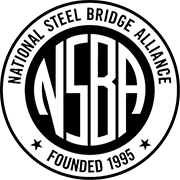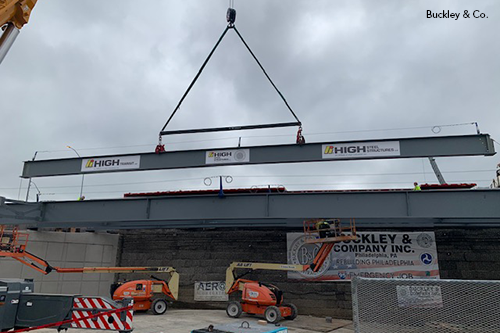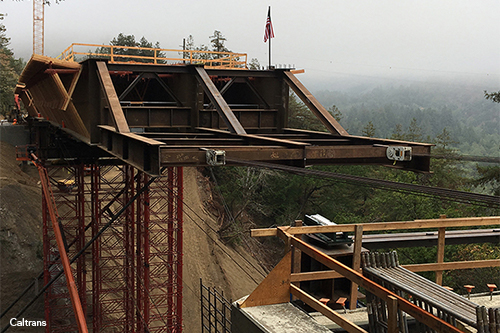National Steel Bridge Alliance
In Case of Emergency, Call the Steel Industry
Catastrophic damages--whether caused by natural disasters or other unforeseen events like vehicular impacts or fires--are a bridge owner's worst nightmare.
When these damages cause bridge failure, the steel industry is there to mobilize and procure material in order to fabricate a new steel bridge at breakneck speed. Read on for all the resources you need to quickly design, fabricate, and construct a steel bridge. Plus find out how the industry leveraged collaboration and state-of-the-art techniques to execute four emergency repairs with great results!
How to Design a Steel Bridge Fast
- Start with standard designs for 1-, 2-, 3-, or 4-span steel bridges
Designers routinely face repetitive design decisions regarding material thickness and sizes for the routine steel I-girder bridges. Optimize the design process with NSBA's straight steel I-girder bridge design templates that are cost-efficient when considering design, material selection, fabrication, and construction. - Estimate the steel superstructure weight
NSBA's Steel Span to Weight Curves tool gives bridge designers a quick estimate of the weight of steel per square foot of bridge deck for straight, low skew, plate girder bridges. Plus, this resource assists with comparing various span arrangements and girder spacings and estimating a potential dollar value for the steel superstructure. - Navigate the AASHTO LRFD Bridge Design Specifications
Use NSBA's Navigating Routine Steel Bridge Design guide to efficiently design and check common bridges according to the AASHTO Specifications. This guide is a series of hyperlinked checklists that walk engineers and designers through the process, step by step, focusing on the specific provisions of the AASHTO Specifications that apply to these routine bridges. - Design steel bridge splices
NSBA Splice takes the time-consuming task of designing and checking a bolted splice connection and rewrites the process with a simple input page and output form. This spreadsheet allows designers to quickly analyze various bolted splice connections to determine the most efficient bolt quantity and configuration. - Choose a corrosion protection option
Speed up steel bridge construction--plus reduce long-term costs and environmental impacts--with uncoated weathering steel (UWS)! UWS has inherent corrosion protection and doesn't require any coating applications, so the steel is ready for erection much faster than coated members. NSBA's Uncoated Weathering Steel Reference Guide describes site and location considerations, design recommendations, structural design, detailing, maintenance, and everything else you need to know to design a bridge with UWS.
Looking for more options? Read about other durability strategies, including single coat of inorganic zinc primer and hot-dipped galvanizing.
How to Fabricate and Construct a Steel Bridge Fast
- Get in touch with a local fabricator
One of the first things an owner should do is call a local fabricator to determine the lead times that they are experiencing and find out how long it could take to procure, fabricate, and deliver steel to the job site. The fabricator will call the steel mills to determine raw material lead times. Often, a fabricator will also reach out to another steel fabricator to obtain the necessary raw material for the project. - Optimize collaboration among parties
The key to accelerated steel bridge fabrication is creating seamless teamwork between the fabricator, owner, engineer, and contractor--and NSBA’s Accelerated Steel: Achieving Speed in Steel Bridge Fabrication is designed to help you do just that. This guide describes how each party's role affects critical shop support activities, which can make or break the fabrication schedule, plus it lays out the ideal schedule for every step of fabrication and the responsibilities of owners, designers, and general contractors. - Perform simple and efficient field repairs and inspections
Once your bridge is finished, it's important to be able to quickly identify and address the most common types of steel highway bridge damage that can occur. Consult the AASHTO/NSBA Steel Bridge Collaboration's G14.2 "Guidelines for Field Repairs and Retrofits of Steel Bridges" for repair procedures, detailing techniques, maintenance recommendations, inspection recommendations, and preservation actions to repair and retrofit steel bridges.
Structural Steel to the Rescue!
When damage occurs, steel bridges don't stay closed for long. With early and close collaboration between fabricators and the rest of the project team, bridge owners can count on well-designed, readily repairable bridges constructed in record time.
Find out how the teams behind four recent bridge projects rallied to reopen these important crossings.
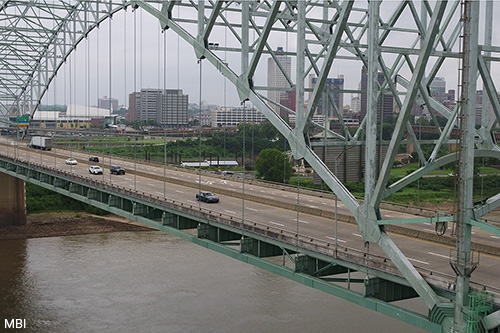 Hernando de Soto Bridge, Memphis, Tenn. to West Memphis, Ark. With close collaboration between two owners, two engineers, a contractor, and multiple fabricators, the bridge reopened just 83 days after the discovery of a partial tie girder fracture. |
|
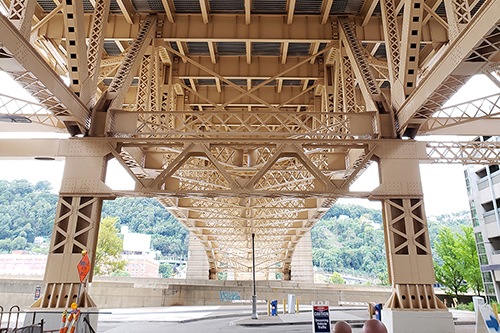 Liberty Bridge, Pittsburgh When a construction fire warped and buckled a main truss compression chord, engineers developed a steel jacking frame concept the same day to fix it. Through a combination of jacking and heat straightening, the member was fully repaired only 24 days after the fire. |
|
